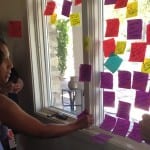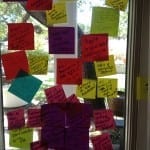Background:
 We recently conducted a Theory of Action process with a capacity building organization, the Progressive Technology Project (PTP), which works with political organizing and social movement groups in the U.S. The group wanted to develop their Theory of Action, but also have a very focused discussion linking the process to decision-making over the next couple years. One of their priorities was ensuring that there was a structured process for deep thinking about impact and alignment of strategies and activities organizationally. The described process shows how ToA can be adjusted and combined with other tools and approaches to meet specific needs.
We recently conducted a Theory of Action process with a capacity building organization, the Progressive Technology Project (PTP), which works with political organizing and social movement groups in the U.S. The group wanted to develop their Theory of Action, but also have a very focused discussion linking the process to decision-making over the next couple years. One of their priorities was ensuring that there was a structured process for deep thinking about impact and alignment of strategies and activities organizationally. The described process shows how ToA can be adjusted and combined with other tools and approaches to meet specific needs.
(Note about this example: The participants knew each other well, brought in-depth knowledge and understanding of the US social movement world and the role of technology as well as familiarity with a variety of group planning and change processes. Given this, we felt comfortable moving through the process relatively quickly). See a few reflections on our process at the end of this post.
Our two-day process:
 (Day 1)
(Day 1)
1) Intro to ToA: Why it matters, how it can be used, etc.
2) Warm up: We spent the first part of the morning talking generally about the question: What are the concrete capacity changes the organization hoped to see in the groups that they were supporting, and why? (Responses were put on post-its on the wall)
3) Vision: Then, we focused specifically on the following question: What did PTP hope the groups they support would be able to do better (in terms of social and political change), because of this increased capacity? (Responses were put up on post-its, roughly aligned with the above)
Note: We chose to discuss the “biggest” vision question 2nd, as we’ve found it easier to engage participants in deeper discussion after they had “warmed-up” a bit and were able to integrate into earlier conversation to ground the vision)
4) Outcome pathways/assumptions:
- Then, instead of just having an open conversation, participants divided into 3-4 small groups and were asked build on question #2 (above) to establish the 3-4 priority changes in capacity they hoped to see in the organizations, and why these were important. We then had an open discussion about where there were agreements or disagreements and came up with an agreed upon list of outcomes. (These were put on post-its on the wall)
- Next, we broke up again in smaller groups, roughly organized by longer-term outcome areas. Each group discussed the earlier
 outcomes and conditions that needed to be reached (or exist) in order for the longer term outcomes to be achieved (and why). Each group wrote their outcomes on post-its and we clustered them around the longer-term outcome area. Then, using “dot democracy” people went to the wall and “voted” on the outcomes they felt were most important in reaching the longer-term outcome, and then discussed their choices with the larger group. (Note: Place around the room were large white sheets of paper with a number of key findings from previous assessments to allow participants to draw from the perspectives of others.)
outcomes and conditions that needed to be reached (or exist) in order for the longer term outcomes to be achieved (and why). Each group wrote their outcomes on post-its and we clustered them around the longer-term outcome area. Then, using “dot democracy” people went to the wall and “voted” on the outcomes they felt were most important in reaching the longer-term outcome, and then discussed their choices with the larger group. (Note: Place around the room were large white sheets of paper with a number of key findings from previous assessments to allow participants to draw from the perspectives of others.)
5) Aligning strategies/activities
We looked at the evolving ToA, and specifically the outcomes that people had prioritized as important for reaching the vision. We discussed the following three question: 1) Where do you feel the organization is focused on achieving, and having traction? 2) Which outcomes are important that the organization isn’t doing much about? 3) Where do you see room for adjustments in strategy/activities? This conversation served to wrap up the day. (Main points of this conversation were charted, and put around the room to inform the conversation the second day)
(Day 2)
 6) Aligning strategies/activities and capacity with vision.
6) Aligning strategies/activities and capacity with vision.
This day took the critical thinking and prioritization that took place during the previous days ToA process and called for the consideration of current resources, capacity, and commitments. The day’s goal was to establish a set of of “strategic guide posts” for the following 12-18 months that would be discussed in greater detail at an upcoming board meeting.
- To start, there was an overview discussion of current obligations (workshops planned, funder commitments, etc.) and realities (resource issues, capacities, etc.)
- Next, each participant discussed what was on his/her plate for the upcoming year.
- We reviewed the prior day’s work, particularly the priority outcomes, and the strategies/activities listed on white paper hung around the room.
- Then, we noted on fresh sheets of white paper all the current and potential activities that were happened, planned, or that someone had considered.
- In small groups, participants then discussed what they felt like the most important priorities needed to be, given the ToA discussion of the prior day.
- Participants came together, and discussed these, and a final round of ‘dot democracy’ (putting colored dots on choices) was done in order to come up with a list of ‘guideposts’ for moving forward.
Reflections on the process
The final ToA map….
 outcomes and conditions that needed to be reached (or exist) in order for the longer term outcomes to be achieved (and why). Each group wrote their outcomes on post-its and we clustered them around the longer-term outcome area. Then, using “dot democracy” people went to the wall and “voted” on the outcomes they felt were most important in reaching the longer-term outcome, and then discussed their choices with the larger group. (Note: Place around the room were large white sheets of paper with a number of key findings from previous assessments to allow participants to draw from the perspectives of others.)
outcomes and conditions that needed to be reached (or exist) in order for the longer term outcomes to be achieved (and why). Each group wrote their outcomes on post-its and we clustered them around the longer-term outcome area. Then, using “dot democracy” people went to the wall and “voted” on the outcomes they felt were most important in reaching the longer-term outcome, and then discussed their choices with the larger group. (Note: Place around the room were large white sheets of paper with a number of key findings from previous assessments to allow participants to draw from the perspectives of others.)
Great job !Like it